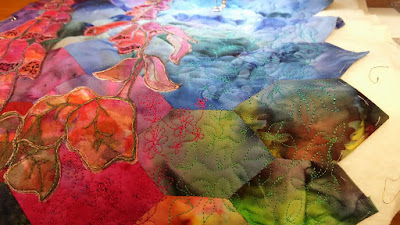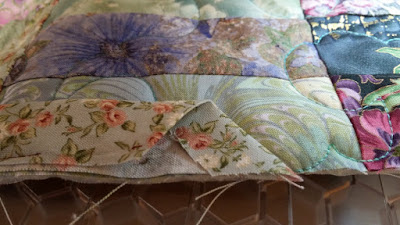Blog 336
Last Thursday, hurricane DORIS caused me to cancel the lunch
I was hosting for friends and kept me indoors. I was on my way to my sewing
room when the power went off. What to do? What to do? I couldn’t do laundry,
hoover the floor, dig the garden, cut back shrubs, and cook a casserole ……..
So I went to my fabrics and started to tidy them up in a
half-hearted sort of fashion and that lasted all of 30 minutes until the power
came back on! On a whim, I picked out one of my most luscious and expensive Heidi
Stoll-Webber fabrics and started to cut and sew. I am revisiting an old
favourite, a block called ’Delectable Mountain’. I cut the fabric into 6” blocks,
the most economical cut for the size of the fabric, and placed them into pairs
with one warm colour (red, orange and yellow) and one cool colour (blue green
and mauve).
I drew a line across the diagonal and sewed a line of
stitches ¼” away on both sides. I then cut along the marked line to divide the
square into 2 half-square triangles. These were pressed ready for the next
stage.
In common with many grandparents, I did a bit of
childminding during half term week. Ella is 7 and full of energy but always
keen to learn so I let her loose on my sewing machine. In the past I have
controlled the food pedal and she has moved thepaper/fabric but this time it
was all her own work. She placed small pieces of sheer onto a layer of
vanishing medium and covered it with a second layer. These were then held
tightly into an embroidery frame. She chose to do rainbow colours in sequence
and learned very quickly how to scribble in circles. Once complete, we soaked
it in hot water to get rid of most of the vanishing medium before placing onto
an up-turned bowl so it would dry to that shape. She had no fear of the machine
and just did it! It was nerve wracking for me watching her but the frame kept
her fingers away from the needle. Phew!






















































